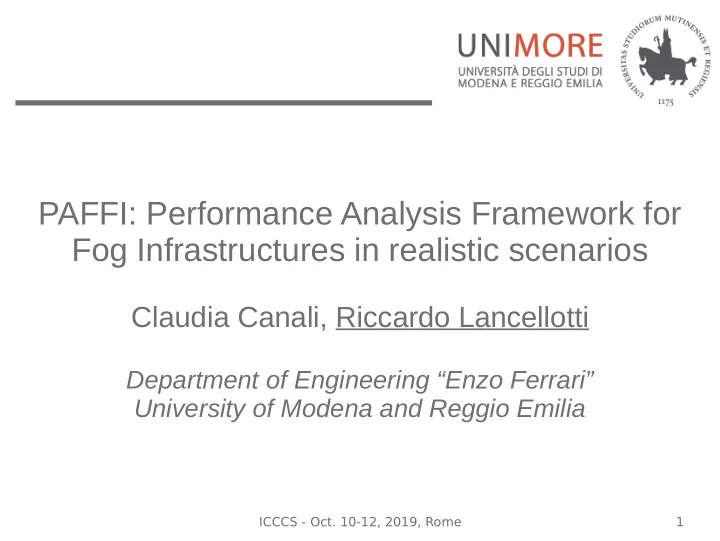

PAFFI: Performance Analysis Framework for Fog Infrastructures in realistic scenarios Claudia Canali, Riccardo Lancellotti Department of Engineering “Enzo Ferrari” University of Modena and Reggio Emilia ICCCS - Oct. 10-12, 2019, Rome 1
Fog computing ● Cyber-physical systems – Distributed sensors – → Huge amount of information to handle ● Cloud approach: – High latency ● Alternative paradigm – Risk of network → Fog computing congestion – Presence of Fog nodes ● Some critical applications: – Data aggregation and – Autonomous driving filtering – Support for smart cities – Latency-bound tasks ICCCS - Oct. 10-12, 2019, Rome 2
Challenges of Fog computing ● Service placement – Which services on fog / cloud ● Data flows mapping – Sensor nodes to fog nodes connection ● Adaptive load balancing – Cooperation strategies ● → Need for realistic scenarios – Use of geo-referenced data – Flexible generation of experimental setups – Help for performance evaluation ICCCS - Oct. 10-12, 2019, Rome 3
Introducing PAFFI ● Performance Analysis Framework for Fog Infrastructures ● Realistic scenarios based on geographic data ● Support for performance analysis → OMNeT++ simulation framework ● Plugin-based approach for topology mapping → arbitrary connections among nodes ● Highly flexible and configurable → Python as main development tool ICCCS - Oct. 10-12, 2019, Rome 4
Performance model ● Performance based on queuing theory ● 3 types of nodes: sensor, fog, cloud ● Description of node behavior: – Outgoing data rate from sensor i: λ i – Processing rate at fog node j: μ j ● Topology connections: – Sensor → Fog connections: x i,j – Fog → Cloud connections: y j,k – Network delay: δ i,j δ j,k ICCCS - Oct. 10-12, 2019, Rome 5
Introducing PAFFI ● Contributions to response time: – Sensor → Fog avg net delay – Fog → Cloud avg net delay – Fog processing time ● Parameters to describe scenarios – Avg net delay – Net / Proc balance – System load ICCCS - Oct. 10-12, 2019, Rome 6
Framework architecture ● 3 main components ● Use of external services – Nominatim API (Open Street Map) – AMPL optimization language – OMNeT++ simulation framework ICCCS - Oct. 10-12, 2019, Rome 7
Geo-referencing ● Input: list of POIs ● Output: geo-referenced and validated data ICCCS - Oct. 10-12, 2019, Rome 8
Scenario generation ● Connect topology: ● Sub-sample data – Naive connection ● Create scenario (nearest node) ( δ i,j δ j,k λ i μ j ) – Optimized connection (AMPL) New connection policies can be easily added ICCCS - Oct. 10-12, 2019, Rome 9
Performance evaluation ● Create OMNeT++ files: – Simulated network description (.ned) – Simulation parameters (.ini) ● Use of template files ICCCS - Oct. 10-12, 2019, Rome 10
PAFFI in action ● Use of geo-referenced data: – Traffic/Air pollution monitoring in Modena ● Scenario Comparison – Naive model Naive – Optimized model ● Representation of sensor → fog mapping ● Uneven distribution of sensors over fog nodes Optimized ICCCS - Oct. 10-12, 2019, Rome 11
Simulations ● Scenario: – Delay: δμ = 10ms Naive – Net/Proc: δμ = 1 – Load: ρ = 0.5 ● Creation of simulation – Leverage OMNeT++ GUI – Built-in analysis tools Optimized ICCCS - Oct. 10-12, 2019, Rome 12
Performance analysis Parameter Naive Mappping Optimized mapping Utilization 0.30, ~1, 0.075 0.54, 0.53, 0.45 Fog Queue length 0.07, >1987, 0.0031 0.33, 0.32, 0.19 Queuing time [ms] 2.2, >17650, 0.41 6.0, 5.9, 4.1 Response time [ms] >12807 30.8 Cloud Queuing time [ms] >12786 5.4 Processing time [ms] 10 10 ● Preliminary performance comparison – Evidence of overload in a fog node for naive mapping – No performance degradation when connections are optimized ICCCS - Oct. 10-12, 2019, Rome 13
Performance analysis Naive Optimized ICCCS - Oct. 10-12, 2019, Rome 14
Another example ● Focus on naive mapping ● Given #sensors, #fog – Sensors for each fog node? – Probability distribution ● Analysis: – Estimate risk of congestion – Create realistic heterogeneous scenarios ● Observation: → for load sharing – Distribution: truncated ● Just another script Gaussian – Create topology – Mean and variance can be quantified – Collect data ICCCS - Oct. 10-12, 2019, Rome 15
PAFFI is available now! Find it in my homepage: http://web.ing.unimo.it/rlancellotti/ Or send me an email: riccardo.lancellotti@unimore.it ICCCS - Oct. 10-12, 2019, Rome 16
Recommend
More recommend